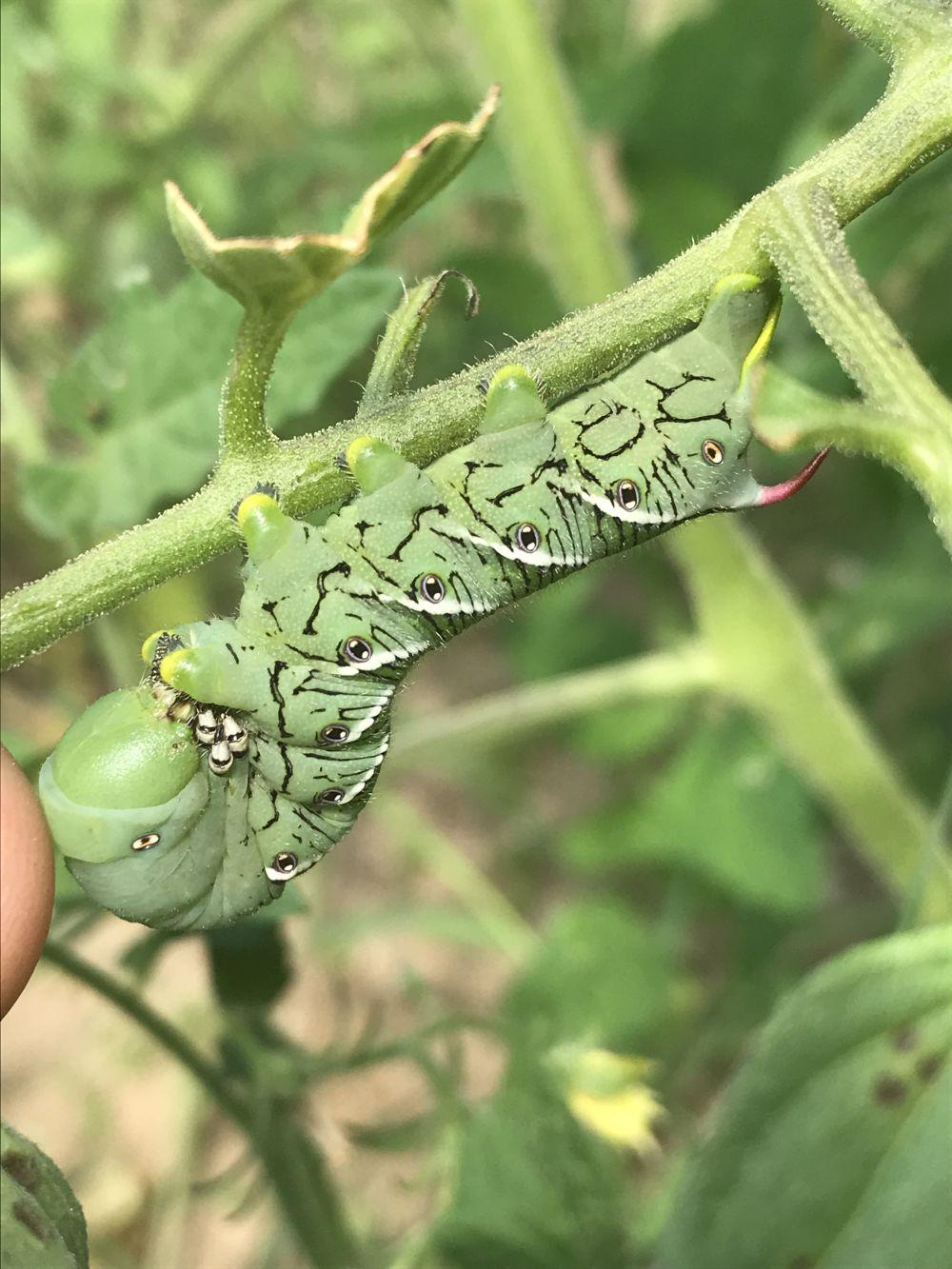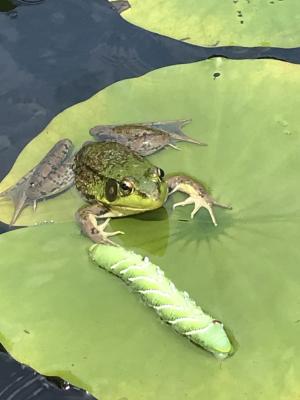Common tomato pests test limits of one intrepid naturalist
- Tags:
- Wildlife,
- Invasives and Pests

Hornworms are huge, ornate, beautifully patterned and repulsive. Gardeners agree: picking bloated, green worms off the tomato plants takes grit.
Leaving the mid-summer forest to the hungry biting deerflies, I spend more time mowing fields or watering and weeding the vegetable garden. Like the forest, the garden provides a miniature ecosystem to study, tend and from which to learn…
As a naturalist, I try to appreciate and understand ecological niches filled by all plant and animal life. Even slimy or creepy-crawly critters have some redeeming purpose. Spiders, snapping turtles, snakes, bats, blackflies, mosquitos - even parasites like ticks - are all animals with bad reputations but they surely serve a purpose in nature. Noxious plants – poison ivy for example – have evolved camouflage, spines, thorns or clever chemical defenses to colonize challenging habitats, repel grazing animals or to attract specific pollinators.
So it becomes difficult for me to explain why a few particular creatures make me squeamish and even queasy. Among them: handling huge hairy spiders, snakes that tend to coil and strike and large writhing green worms. Three – that’s it. Each is capable of making me wobbly in the knees, particularly if I am not prepared for an encounter. I try not to show it; but then my voice cracks.

Cue the sci-fi theme music for this annual garden “harvest” in the midst of summer weeding and watering. Picking hornworms from our tomato plants takes me from shudder to shrieks if they latch on. I know it’s irrational but they are gross!
Tomato hornworms and their closely related cousins, tobacco hornworms are huge, ornate, beautifully patterned and repulsive. Most gardeners agree: picking bloated, green worms off the tomato plants takes grit. Failure to remove hornworm caterpillars from plants guarantees they will be completely defoliated in days. Picking caterpillars is not optional if you enjoy delicious, sun-ripened backyard tomatoes.
Two related hornworm caterpillars are the larval stages of two different hawkmoths. Tomato hornworms mature to become five-spotted hawkmoths. Tobacco hornworms (also called “goliath worms”) become tobacco hawk moths also called “Carolina sphinx moths.” These larval hornworm caterpillars feed exclusively on tomatoes, eggplants, peppers, tobbcco and potato plants - members of the “nightshade” plant family that includes other plants that produce toxic alkaloids including “deadly nightshade.” American colonists once believed tomatoes themselves were also poisonous.

The adult hawkmoths that develop from hornworms feed on the nectar of large, fragrant white flowers of evening primroses or an annual, ornamental shrub “Datura” also called “moonflower.” Fast-flying hawkmoths are the primary pollinators for these plants. The moths are equipped with a ten-centimeter tubular “proboscis” - a coiled hollow straw - for drawing nectar from deep, tubular flowers. The nectar of Datura flowers contains alkaloids known to affect moths observed flying erratically and exhibiting uncoordinated failed landing attempts yet continuing to seek the intoxicating nectar of these flowers.
Research suggests tobacco hornworms are more common in the southern US and tomato hornworms are more prevalent in the north. A colleague who has trapped and released more than 800 moth species this summer using an UV light and funnel trap shares that “looking at where people have reported seeing tobacco hornworm moths, there are plenty of sightings in NH and into Canada. The moth field guide range maps make it seem like they are occasional or even uncommon in northern New England but clearly that is not the case.”
I collected 30 fat green caterpillars from our tomato plants over two days. All of them were tobacco hornworms. Both hornworm species feed on tobacco or tomato plants so the host plant does not indicate which caterpillar it is. Both have a prominent horn on their rear end, hence their name. Tobacco hornworms have red horns and tomato hornworms have dark blue or black horns. Tomato hornworms have eight V-shaped white markings. Tobacco hornworms have seven white diagonal stripes with a black border. An internet source suggests remembering parallel white stripes look like tobacco cigarettes and the “V-“ is for “vine-ripened.”
The caterpillar life cycle takes 30 to 50 days. Larvae hatch from eggs laid by adult moths in early summer and develop through five different body stages called “instars.” They continue to feed until late summer when they drop off plants to burrow into the soil to form a pupa that overwinters underground. Large, ornate gray moths emerge the following spring to sip nectar, mate and lay eggs singly on the leaves of their preferred host plants.
I interrupted that life cycle. My photo collection of fat, finger-size wriggling caterpillars amused or horrified Facebook friends. I made a video showing how to remove them from a tomato plant starting with the posterior “horn” end. When the squiggly tiny front legs and mouth parts clasped at my finger, I squealed. Intrepid naturalist?

Online friends suggested caterpillar disposal strategies – ziplock bag and leave in the sun or place in the freezer, squish them or even obtain a military flame-thrower? Memes appeared ranging from “Game of Thrones” dragons to William Hurt in the movie “Aliens.” One friend provided a recipe for “fried green tomato (hornworms).” Appetizer anyone? No thanks.
Other gardeners also reminded me to NOT remove any hornworm caterpillars covered with small rice-like grains on their bodies. These are the eggs of Braconid wasps that parasatize the hornworms, quickly killing them. By leaving wasp eggs intact, it helps ensure future generations of wasps to kill future generations of hornworms; an elegant natural pest control solution.

Formerly I fed the caterpillars to our backyard chickens which wasted no time consuming them – very satisfying to convert pests to fresh eggs. No more chickens on our farm – the myriad predators made it impractical. So I added the bumper hornworm harvest to the lilly pond – a water feature complete with a solar-powered fountain, an elegant setting.
Most hornworms drowned but a few wriggled onto lilly pads and drew the attention of resident frogs. One frog made a huge meal of a hornworm nearly its own size! I figure at least there is virtue in recycling. No word on psychoactive frogs but if I start finding more frogs in the vegetable garden, I’ll know why.

To learn about finding, identifying and sharing moth and caterpillar sightings, visit:
The Field Guide for Lepidoptera https://leps.fieldguide.ai/figures
Digital Guide to Moth Identification from from the Mississippi Entomological Museum for good range maps, records of sightings locations and photos. http://mothphotographersgroup.msstate.edu
Butterflies and Moths of North America BAMONA at https://www.butterfliesandmoths.org
